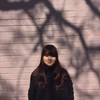Edward: I started shooting the series when I went to Russia last year. It had always stood out as a totally foreign social and political sphere to Australia. Even when I arrived, I remember thinking "I have no idea what this place is going to look and feel like." I flew into Moscow and then traveled through Siberia all the way to the Mongolian border and from there, up to the arctic. After that I traveled to Kyrgyzstan, Kazakhstan and Georgia.Tell me where the name of the series comes from.
It came from text written on an abandoned house in a place called Teriberka. In the quote, 'All I Had to Give,' I liked the idea of my photography presenting this dualistic or ambiguous idea: a celebration of putting everything you have into life or alternatively, being depleted or exhausted after giving everything you possessed.There's this conscious pause between the viewer and the subject. What draws you to portraits?
It sounds a little dull, but I'm often simply drawn in by interesting characters, especially a lot of the older people there, who wear stories on their faces. There was a huge language barrier too, which was nice in a way because the people were often still a bit of a mystery to me. I met some amazing people—one of my favourites was this man, an Old Beliver, who worked on a river barge near Ezhey. To get to there, I took a 20 hour train ride to Abakan, where I then spent another 8 hours in a marshrukta [shared van] to get to the Tuvan Republic, near the border to Mongolia. We didn't speak to one another at all, I just gestured whether it was okay to take a photo—he then took on this really formal posture, which reminded me of an old portrait. I found that guy really fascinating.
My brother owns a gallery and darkroom, so the exhibition was really inspired by getting back to basics. In my advertising and commercial work, what's really prominent is photoshopping and treating the shit out of everything. For this series, I shot film and printed in a darkroom with no manipulation to the images—a woman came in to the darkroom the other day to literally hand-paint scratches off.Would you say it's your authentic self coming out?
Definitely. I think it shares aesthetic qualities to some of my day-day work but the process has been much more personal. A lot of my motion work is pretty manicured and requires a huge crew, costs a lot of money and everything takes a long time. Things often get overworked. This series has been about getting back to basics—it's been really liberating that it's just me and a small camera. It's really nice being more intuitive and not overthinking decisions too much.'All I Had I Gave' works entirely on black and white film. Was there a process of selection when capturing a scene?
With black and white film, one of the things I like about the medium is that it doesn't have a set place in a time or era. I like that some of these shots could have been taken 30 odd years ago. I also love film for the simplicity of it. In terms structuring an image, I tend to gravitate towards portraits rather than straight landscapes.
I've been really lucky with approaching people—I'm a bit dorky and clumsy—which I think puts them at ease in a way. Russia was a bit tough at times because people were often a bit wary of having their photo taken. Georgia and Kyrgyzstan were much easier.What can people expect from the rest of your series and exhibition, 'All I Had I Gave'?
I've done 15 mural-sized prints along with a book, which has been a massive undertaking. I didn't really know what I was getting myself into. Four Pillars and Capi were amazingly generous and sponsored the show. To be honest, I don't have any real expectations, just excited to share the work."All I Had I Gave" is a collection of portraits set against the crumbling backdrop of once mighty Cold War powers. More info on the opening here.Words by Monique Myintoo. Follow her on Twitter.
One of the many housing estates in Murmansk, Russia
Construction in Moscow, Russia.
Kochkor, Kyrgyzstan.
Old couple in the backstreets of Tbilisi, Georgia.
Peak hour at the bus depot, somewhere in the Golden Ring, Russia.
Market in Tbilisi, Georgia.
Woman at her market stall in Tbilisi, Georgia.
Decayed statue, somewhere outside of Bishkek, Kyrgyzstan.
Market in Tbilisi, Georgia.
Trans-Siberian Railway, Russia.
Graveyard in Kochkor, Kyrgyzstan.
Herder in Issyk Kul, Kyrgyzstan .
Braving the cold at Lake Baikal, Russia.
Smoked Omul, Lake Baikal.
Old Believer in Ezhey, Russia.
Overgrown graveyard in Teriberka, Russia.
Barge in front of Old Believer village in Ezhey, Russia.
Little girl playing after school in Murmansk, Russia.
Teriberka, Russia.
